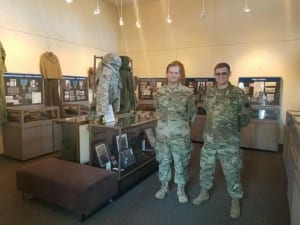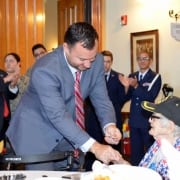How to Run A Veterans Day Ceremony at Your Local Jewish Community Center, Synagogue or School

Department of Rhode Island
By Barry Lischinsky, National Membership Chairman
How to Run A Veterans Day Ceremony at Your Local Jewish Community Center, Synagogue or School
What is the purpose of JWV Posts running Veterans Day ceremonies?
Veterans Day is an excellent opportunity for JWV Posts to interact with their local Jewish communities – to remind them that Jewish veterans exist and live among them. We must capitalize on this opportunity by reaching out to our local JCCs, synagogues and schools in order to remind the Jewish community of their proud and historic service to the United States.
What is Veterans Day?
Veterans Day originated as “Armistice Day” on Nov. 11, 1919, the first anniversary of the end of World War I. Congress passed a resolution in 1926 for an annual observance, and Nov. 11 became a national holiday beginning in 1938. Unlike Memorial Day, Veterans Day pays tribute to all American veterans—living or dead—but especially gives thanks to living veterans who served their country honorably during war or peacetime.
What is the importance of the 100th anniversary of the Armistice of WWI?

JWV Members setting up Veterans Day exhibit in the Merage JCC.
This Veterans Day is the 100th anniversary of the Armistice (the peace agreement) of World War 1 (WW1). WW1 remains America’s forgotten war, even though more Americans gave their lives in that war than the wars of Korea and Vietnam combined. More than four million American families sent their sons and daughters to serve in uniform during World War 1, and 225,000 American Jews served in that war – many of them new immigrants. It was also the first time women were formally introduced into the Army, and we are proud to say that the first female doctor in the US Army, Kate Karpeles, was a proud Jewish woman and the daughter in law to a Jewish Medal of Honor Recipient. By learning and teaching our community about our service, we are not only teaching the next generation, but we are also making a promise to this generation of soldiers and sailors that their service will not be forgotten 100 years from now.
How do I run a Veterans Day Ceremony?
The ceremony itself consists of 8 parts: (1) Posting of the Colors, (2) Pledge of Allegiance and National Anthem, (3) Introductory Remarks, (4) Introduction of Special Guests, (5) Principal Speaker, (6) Special Reading, (7) TAPS and (8) Closing Benediction.
- Prelude and Posting of Colors —A procession and posting of the Nation’s colors (the American Flag) is always a moving event. Local veterans service organizations or JROTC programs often participate with their impressive array of military banners and American flags.
- Pledge of Allegiance and the National Anthem — The program chairperson should invite the audience to stand and join in the Pledge of Allegiance and singing of the National Anthem.
- Introductory Remarks — Brief introductory remarks can set the tone for the program. This year, it would be appropriate to give a brief history of WW1 and the impact that it has had through our nation. A guide on WWI can be found at the WW1 Centennial Commission website, and information about Jewish soldiers during WW1 can be found at the National Museum of American Jewish Military History
- Introduction of Guests — Dignitaries selected as special guests may include local government officials, distinguished military personnel and veterans from your community should be introduced at the event.
- Principal Speaker — Your principal speaker should be invited far enough in advance to allow adequate preparation for your program. JWV is able to provide speakers through our Project Maggid program. Please contact JWV’s Programs Department if you are interested in getting a speaker.
- Selected Reading —A reading of a well-known patriotic address by a famous military hero by a talented student can be effective. Selected readings are available from the National Museum of American Jewish Military History.
- Moment of Silence, Taps — While Veterans Day is primarily a tribute to America’s living veterans, and should be observed more as a celebration than as a somber remembrance, it is always appropriate to include a moment of respect for those who gave their lives for their country. This year, the Jewish community lost two American heroes in the line of fire – Captain Samuel Schultz and SFC Christopher Celiz. It is important to remind the Jewish community of their stories and the stories of the other 15,000 current Jewish service members.
- Closing Benediction — Inviting a local Rabbi or a lay leader can be a meaningful way to end the ceremony. The Prayer for America’s Military Personnel is appropriate. A link to the lyrics and musical accompaniment can be found at the JWB Jewish Chaplain’s Council










